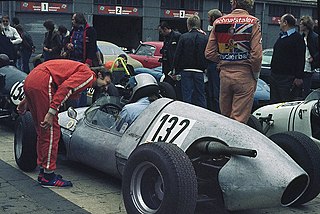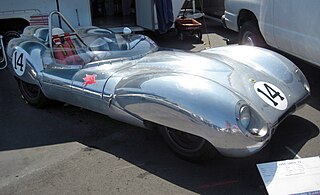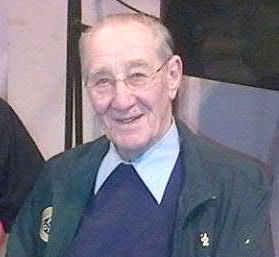
The Lotus Seven is a small, simple, lightweight two-seater open-top sports car produced by the British manufacturer Lotus Cars between 1957 and 1972.

Cosworth is a British automotive engineering company founded in London in 1958, specialising in high-performance internal combustion engines, powertrain, and electronics; for automobile racing (motorsport) and mainstream automotive industries. Cosworth is based in Northampton, England, with American facilities in Indianapolis, Shelby Charter Township, Michigan and Mooresville, North Carolina.

Lotus Cars Limited is a British automotive company headquartered in Norfolk, England. It manufactures sports cars and racing cars noted for their light weight and fine handling characteristics.

The Lotus Elite name has been used for two production vehicles and one concept vehicle developed and manufactured by British automobile manufacturer Lotus Cars. The first generation Elite Type 14 was produced from 1957 to 1963 and the second generation model from 1974 to 1982. The Elite name was also applied to a concept vehicle unveiled in 2010.

Anthony Colin Bruce Chapman was an English design engineer, inventor, and builder in the automotive industry, and founder of Lotus Cars.

The Lotus Europa name is used on two distinct mid-engine GT cars built by British automobile manufacturer Lotus Cars. The original Europa and its variants comprise the Lotus Types 46, 47, 54, 65 and 74, and were produced between 1966 and 1975.

The Ford Kent is an internal combustion engine from Ford of Europe. Originally developed in 1959 for the Ford Anglia, it is an in-line four-cylinder overhead-valve–type pushrod engine with a cast-iron cylinder head and block.

Lotus Elan is the name of two separate ranges of automobiles produced by Lotus Cars. The first series of cars was produced between 1962 and 1975 as a rear-wheel drive vehicle. The second series was produced between 1989 and 1995 as a front-wheel drive vehicle.
Lotus Cortina is the commonly used term for the Ford Cortina Lotus, a high-performance sports saloon, which was produced in the United Kingdom from 1963 to 1970 by Ford in collaboration with Lotus Cars. The original version, which was based on the Ford Cortina Mark 1, was promoted by Ford as the "Consul Cortina developed by Lotus", with "Consul" later being dropped from the name. The Mark 2 was based on the Ford Cortina Mark II and was marketed by Ford as the "Cortina Lotus". Lotus gave the model the type number designation Type 28.

Coventry Climax was a British forklift truck, fire pump, racing, and other specialty engine manufacturer.

The Chapman strut is a design of independent rear suspension used for light cars, particularly sports and racing cars. It takes its name from, and is best known for its use by, Colin Chapman of Lotus.

Formula Junior is an open wheel formula racing class first adopted in October 1958 by the CSI. The class was intended to provide an entry level class where drivers could use inexpensive mechanical components from ordinary automobiles. The idea to form the new class came from Count Giovanni "Johnny" Lurani who saw the need of a class for single-seater racing cars where younger drivers could take their first steps. It is often speculated that this class was founded as a reaction to Italy's lack of success in the 500cc Formula Three, and although Italian marques dominated the first year of the formula, they were soon overtaken by British constructors.

Elva was a sports and racing car manufacturing company based in Bexhill, then Hastings and Rye, East Sussex, United Kingdom. The company was founded in 1955 by Frank G. Nichols. The name comes from the French phrase elle va.
Hewland is a British engineering company, founded in 1957 by Mike Hewland, which specialises in racing-car gearboxes. Hewland currently employ 130 people at their Maidenhead facility and have diversified into a variety of markets being particularly successful in electric vehicle transmission supply.

Turner Sports Car Company Limited was a 1950s British sports car manufacturer, that closed in 1966.

The Lotus Eleven is a sports racing car built in various versions by Lotus from 1956 until 1958. The later versions built in 1958 are sometimes referred to as Lotus 13, although this was not an official designation. In total, about 270 Elevens of all versions were built.

The Lotus 23 was designed by Colin Chapman as a small-displacement sports racing car. Nominally a two-seater, it was purpose-built for FIA Group 4 racing in 1962–1963. Unlike its predecessors Lotus 15 and 17, the engine was mounted amidship behind the driver in the similar configuration developed on Lotus 19.

The Lotus Mark VIII car was Colin Chapman’s first fully enclosed aerodynamic design. Chapman's basic requirements for the design were for a car of 1100 lbs powered by an 85 bhp engine and a maximum speed of 125 mph. Work began on this design in late 1953 and Chapman was assisted in the design of the body by the aerodynamicist Frank Costin, who was the brother of Mike Costin, his main collaborator.

The Lotus 15 is a front-engine sports racing car designed by Colin Chapman of Lotus, built from 1958 until 1960.

Leonard E. Terry was an English racing car designer and engineer, known for his work with Lotus, BRM and Eagle. He also designed chassis for many other teams, including ERA and Aston Martin and produced his own car in which he competed.


















